6.8 Fireplaces, chimneys and flues
SITEWORK STANDARDS
| 6.8-S1 | Sitework standards |
| 6.8-S2 | Fireplaces and hearths |
| 6.8-S3 | Flues |
| 6.8-S4 | Chimneys |
| 6.8-S5 | Terminals |
| 6.8-S6 | Provision of combustion air |
| 6.8-S7 | Testing |
(a) meet the Technical Requirements
(b) take account of the design
(c) follow established good practice and workmanship
Sitework that complies with the design and the guidance below will be acceptable for fireplaces, chimneys and flues. Gas appliances should be fitted by a registered CORGI installer to comply with the Gas Safety (installation and use) (amendment) Regulations 1990.
Good workmanship and effective supervision during construction are essential to ensure that fireplaces, chimneys and flues function correctly in use.
Additional construction details are shown in Appendix 6.8-C.
FIREPLACES AND HEARTHS
Fireplace recesses should be constructed of solid non-combustible material as shown below: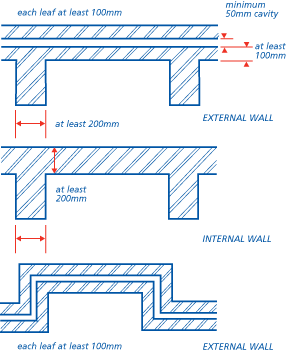
The space between a fireback and any masonry forming the recess should be filled with vermiculite concrete (1 : 4, lime : vermiculite with water).
Combustible material should not be placed under a constructional hearth unless it is:
- to support the edges of the hearth or
- separated from the underside of the hearth by an airspace of at least 50mm or
- at least 250mm from the material to the top of the hearth.
Hearths should be at least the sizes shown below. Hearths for freestanding appliances should be at least 840mm square.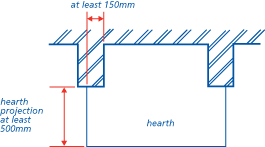
FLUES
Items to be taken into account include:
(a) cleaning
The bottom of flues not directly over an appliance should be provided with a means of access for cleaning and inspection.
(b) connections to appliances
The connection between a fireplace or appliance and the flue should be correctly constructed (see details in Appendix 6.8-C).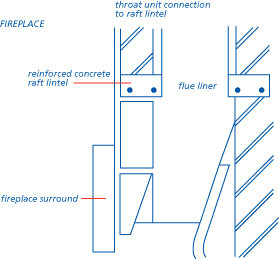
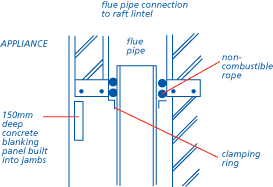
(c) flue draught control unit
Where adjustable throat units are specified they should be fitted in accordance with manufacturers' instructions. Adjustable flue draught control units are not permitted where gas burning appliances are installed.
(d) flue pipes
Flue pipes should be fixed 'socket up' and correctly aligned. Longer flue pipes forming flues from gas appliances should be supported at a maximum of 1.8m centres and have support directly below each socket.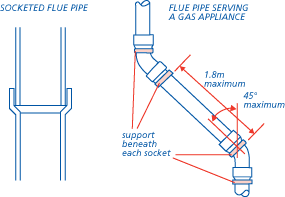
(e) flue liners
The space between flue liners and masonry should be filled with weak insulating concrete or manufacturers' recommendations with specified material providing adequate protection.
Flue linings to chimneys should be clay or purpose made concrete as specified by the design.
Flue linings should be handled carefully to prevent chipping or cracking.
Bends or tees should be purpose made for use with the lining system being installed.
Flue linings should be sealed at their joint with the starter block or throat unit. No cavity should be formed between the linings and the starter elements.
Flue linings should be installed socket up.
Changes of direction of flue liners should be formed using purpose made fittings.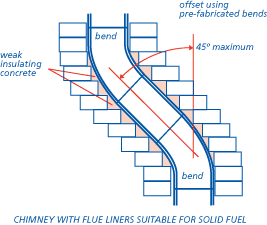
Jointing material for flue liners should be fire cement or refractory mortar, unless the manufacturers' instructions require an alternative jointing to be used.
Each joint should be fully filled and all surplus material cleared from the inside of each joint as the flue is built.
(f) fire hazards
Combustible materials close to any brick or blockwork chimney should be:
- at least 200mm from a flue, or
- except in Scotland, 40mm from the face of the chimney.
This does not apply to a floorboard, skirting, dado or picture rail, mantelshelf or architrave.
Metal fixings in contact with combustible materials should be at least 50mm from a flue.
CHIMNEYS
Items to be taken into account include:
Masonry chimneys should be properly bonded to, or supported by, adjoining walls of the building. The depth of chimney foundations should be the same as any adjacent wall foundation.
The height H of an unrestrained chimney should not exceed 4½ times the least plan dimension of the chimney W (see diagram), provided the density of the masonry is at least 1500kg/m3, unless designed by an Engineer in accordance with Technical Requirement R5.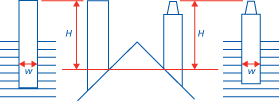
Chimneys of block, brick or stone should have a minimum wall thickness of 100mm excluding the lining thickness.
A chimney forming part of a compartment wall and not back to back with an adjacent chimney should have a wall thickness of at least 200mm separating it from the other building or dwelling.
Chimneys built in a cavity separating wall should form two leaves each of at least 100mm thickness between the flue and adjoining building.
The damp proof course to the main walls should be carried through the base of chimneys.
Damp proof courses, flashings and gutters should be provided at the intersection point of the chimney with the surface of the roof through which the chimney passes.
Metal elements making up dpcs and flashing should be compatible non-ferrous metals. Lead trays should be bitumen coated where in contact with cement.
Occasional damp penetration below roof level may occur in chimneys which exit close to the ridge of a pitched roof. This is acceptable in a well ventilated roof space provided that any dampness penetrating downwards is unlikely to reach the living areas.
Where chimneys exit close to the eaves of a pitched roof or through a flat roof, trays and flashings should be installed in the chimney so that all damp penetration is prevented.
The weatherproofing details shown in Appendix 6.8-C should be used in Very Severe and Severe exposure zones. In lower exposure zones the tray upturn may be on the outside of the flue liner.
A core is a sack, full of loose straw or the like, used to block the flue during the construction of a chimney with circular linings. The core, which is attached to a rope to pull it up the flue, keeps the flue clean and free of falling mortar and debris which may later form an impedance to gases passing through the flue. Ensure that the core is removed on completion of the chimney.
A chimney should be allowed to dry naturally for at least 14 days before use.
BRICKS
Frost resistant bricks should be used above the roof unless protected by a capping projecting at least 50mm. In Scotland, frost resistant bricks should be used for all facing brickwork.
Below roof level the bricks and mortar may be the same as those used for general brickwork.
Mortar should be as specified for areas of Severe and Very Severe exposure in Chapter 6.1 'External masonry walls' Appendix 6.1-C. (1 : ½ : 4 to 4½, cement : lime : sand or 1 : 3 or 4, cement : sand with plasticiser).
Sulfate resisting cement should be used in the mortar where flue gases are liable to affect the masonry, eg. above roof level.
BLOCKS
Hollow or cellular blocks, suitable for the construction of chimneys, should only be used if the voids are filled with concrete as the work proceeds.
Gas flue block chimneys are only suitable for gas appliances. Their suitability should be checked before connecting any appliance.
Flue block chimneys should be constructed, jointed and weather proofed in accordance with the design and manufacturers' instructions. A high standard of workmanship should be maintained to ensure that the flue is clean and sealed.
Flue blocks should be correctly bonded to the flanking masonry.
Where gas flue blocks are shown in the design they will be at least 140mm wide. This may be wider than the wall leaf.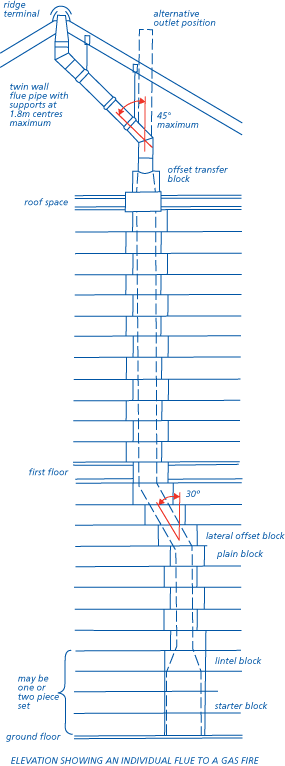
The design will show how the extra thickness is incorporated by either:
- increasing the overall width of the cavity, or
- making the flue block flush with the inside of the cavity but projecting into the room as a false chimney breast.
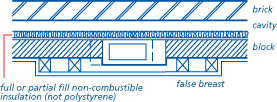
Where the cavity is shown to be reduced the flue block should be protected by a vertical dpm. The dpm should be supported by building in a layer of non-combustible insulation.
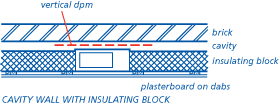
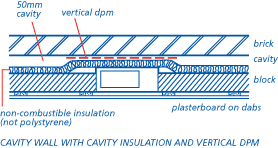
Plaster should not be applied directly to flue blocks. A plasterboard lining with an airspace or non-combustible insulation behind should be provided. Insulated dry lining may be unsuitable in this situation unless separated from the flue block.
Connections between flue blocks and ridge terminals should be made as detailed in the design using the correct fittings and supports as specified by the manufacturers of the flue blocks, flue pipe and the ridge terminal.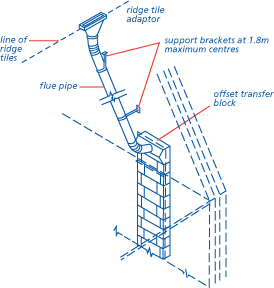
Factory-made insulated chimneys should be assembled, erected, anchored and protected in accordance with manufacturers' instructions.
TERMINALS
Terminals should be purpose made or formed by extending the flue lining not less than 20mm above the head of the chimney. Various terminals are shown in Appendix 6.8-C.
Items to be taken into account include:
(a) stability
Terminals should be embedded at least 125mm into the chimney excluding any flaunching, or one quarter the length of the terminal, whichever is the greater.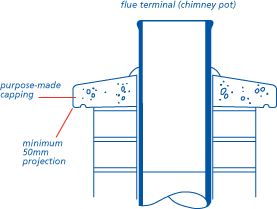
Appendix 6.8-C gives details of brickwork capping.
(b) jointing
The terminal of a masonry flue should be jointed to the flue lining with cement mortar to form a seal.
(c) size
Terminals should be the same cross sectional area as the flue which for solid fuel is not less than 200mm diameter.
(d) draught improvement
In cases where down draughts may occur, special terminals designed to increase up draught should be fitted.
A special terminal will not overcome problems caused by high pressure zones. Where relevant, the Solid Fuel Association or other authoritative body should be consulted.
(e) chimney capping
Where a chimney is to be capped, a single unjointed concrete or stone capping should be used. The capping should project and be throated to cast rainwater away from the face of the chimney. The slab should project 50mm beyond the faces of the chimney. The withes between flues should be carried to the underside of the slab.
Decorative brick cappings should be carefully constructed to avoid rain penetration and frost damage. The use of frost resistant bricks may be required. All bricks used for facing brickwork in Scotland should be frost resistant.
PROVISION OF COMBUSTION AIR
Combustion air is vital to the safe and efficient operation of appliances. Reference should be made to Appendix 6.8-A.
TESTING
ALL FLUES
All flues should be checked during construction to ensure that there are no obstructions in the flue and that mortar or other blockages are removed. When the flue is complete, if practical a visual check should be made and any obstructions cleared.
FLUES FOR SOLID FUEL APPLIANCES
Coring ball test
When a visual test cannot be carried out or is inconclusive, the coring ball test should be carried out.
A suitable concrete or metal ball is attached to a strong cord or rope. The ball is lowered slowly from the flue outlet to the bottom of the flue (the fireplace recess or the appliance connection). If a blockage or obstruction is found it must be removed and the test repeated until the flue is completely clear of obstruction.
Smoke test
This test is designed to show that a flue draws adequately and that there are no leaks between the appliance and the terminal.
The smoke test is carried out when neither the flue to be tested nor adjacent flues are in use. The flue is first warmed for about 10 minutes with a heat source such as a blow lamp. If an appliance is fitted it should be completely closed as should any flue access doors.
Two purpose made smoke pellets are then placed in the appliance firebox or in the bottom of the flue and ignited. The appliance, chimney or fireplace opening should then be closed or sealed off and the smoke allowed to rise. When smoke appears at the top of the flue the outlet should be sealed with a blow-up rubber ball or other air tight closing system.
The whole structure forming the flue should be inspected externally on all sides and from top to bottom for smoke leakage. This should include the top of cavity walls and any other possible smoke paths, even those terminating some distance from the flue. The test should be continued for at least 5 minutes.
FLUES FOR GAS APPLIANCES
More sophisticated flue tests may be required for some gas appliances. These tests should be carried out by the appliance installer.
FLUES FOR OIL APPLIANCES
Flues for oil fired appliances should be tested as required by the appliance manufacturer.





















